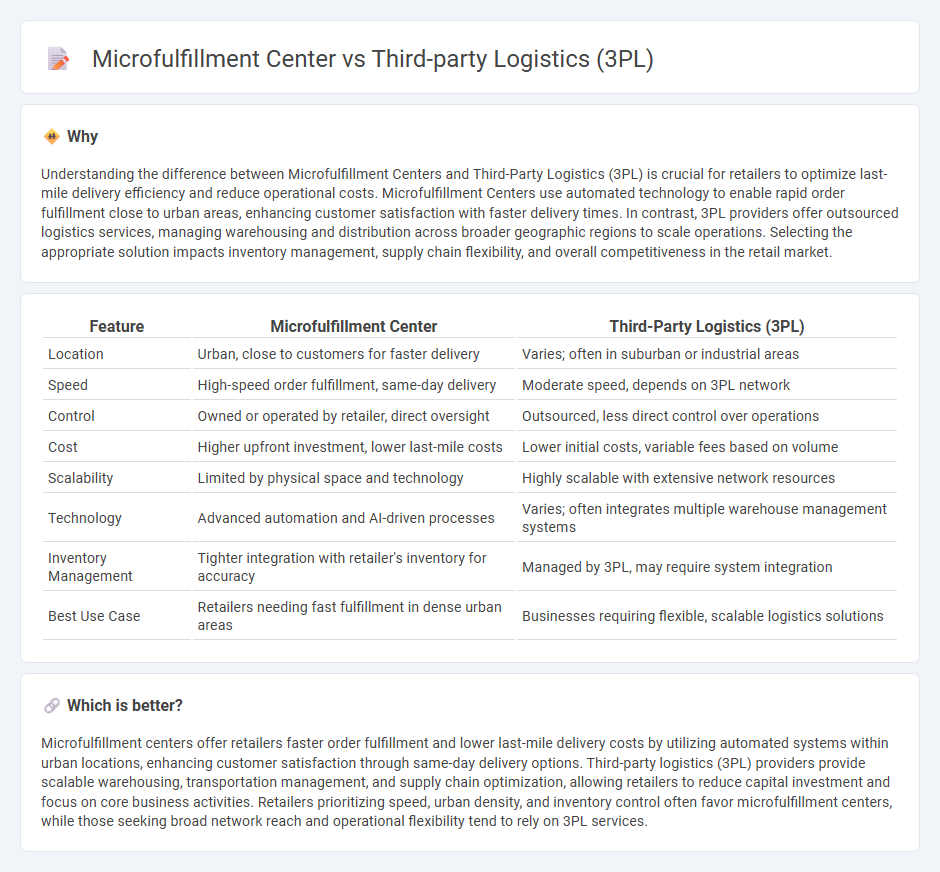
Microfulfillment centers leverage automation and advanced robotics to enable faster inventory turnover and last-mile delivery within urban retail environments, significantly reducing order fulfillment times. Third-party logistics (3PL) providers offer comprehensive supply chain solutions, including warehousing, transportation, and distribution services, giving retailers scalable flexibility without heavy capital investment. Discover how these strategies can optimize your retail supply chain efficiency and customer satisfaction.
Why it is important
Understanding the difference between Microfulfillment Centers and Third-Party Logistics (3PL) is crucial for retailers to optimize last-mile delivery efficiency and reduce operational costs. Microfulfillment Centers use automated technology to enable rapid order fulfillment close to urban areas, enhancing customer satisfaction with faster delivery times. In contrast, 3PL providers offer outsourced logistics services, managing warehousing and distribution across broader geographic regions to scale operations. Selecting the appropriate solution impacts inventory management, supply chain flexibility, and overall competitiveness in the retail market.
Comparison Table
| Feature | Microfulfillment Center | Third-Party Logistics (3PL) |
|---|---|---|
| Location | Urban, close to customers for faster delivery | Varies; often in suburban or industrial areas |
| Speed | High-speed order fulfillment, same-day delivery | Moderate speed, depends on 3PL network |
| Control | Owned or operated by retailer, direct oversight | Outsourced, less direct control over operations |
| Cost | Higher upfront investment, lower last-mile costs | Lower initial costs, variable fees based on volume |
| Scalability | Limited by physical space and technology | Highly scalable with extensive network resources |
| Technology | Advanced automation and AI-driven processes | Varies; often integrates multiple warehouse management systems |
| Inventory Management | Tighter integration with retailer's inventory for accuracy | Managed by 3PL, may require system integration |
| Best Use Case | Retailers needing fast fulfillment in dense urban areas | Businesses requiring flexible, scalable logistics solutions |
Which is better?
Microfulfillment centers offer retailers faster order fulfillment and lower last-mile delivery costs by utilizing automated systems within urban locations, enhancing customer satisfaction through same-day delivery options. Third-party logistics (3PL) providers provide scalable warehousing, transportation management, and supply chain optimization, allowing retailers to reduce capital investment and focus on core business activities. Retailers prioritizing speed, urban density, and inventory control often favor microfulfillment centers, while those seeking broad network reach and operational flexibility tend to rely on 3PL services.
Connection
Microfulfillment centers enhance retail efficiency by enabling rapid order processing within urban areas, reducing last-mile delivery times. Third-party logistics (3PL) providers integrate these microfulfillment centers into their supply chain networks to offer scalable, flexible distribution solutions. This collaboration improves inventory management and customer satisfaction by combining localized fulfillment with expert logistics services.
Key Terms
Outsourcing
Third-party logistics (3PL) providers offer comprehensive outsourcing solutions encompassing transportation, warehousing, and inventory management, enabling businesses to scale efficiently without heavy capital investment. Microfulfillment centers specialize in localized, automated order fulfillment within urban areas, optimizing last-mile delivery and reducing delivery times for e-commerce and retail sectors. Explore the key differences and benefits of outsourcing through 3PL versus microfulfillment centers to enhance your supply chain strategy.
Automation
Third-party logistics (3PL) providers leverage automation primarily for efficient inventory management, order processing, and transportation coordination, enhancing scalability and cost savings across supply chains. Microfulfillment centers utilize advanced robotics and AI-driven systems to automate the picking and packing processes within urban warehouses, optimizing speed and reducing last-mile delivery times. Explore how integrating these automation technologies transforms logistics operations and boosts customer satisfaction.
Last-mile delivery
Third-party logistics (3PL) providers specialize in managing comprehensive supply chain operations, including transportation, warehousing, and distribution, offering scalable solutions across multiple regions. Microfulfillment centers prioritize last-mile delivery efficiency by utilizing automated, small-scale warehouses located near urban areas, significantly reducing delivery time and costs. Explore how leveraging 3PL and microfulfillment strategies can optimize your last-mile delivery performance.
Source and External Links
What is 3PL (third-party logistics)? | Definition from TechTarget - A 3PL provider offers outsourced logistics services managing one or more facets of procurement and fulfillment, such as transportation management or warehouse space, allowing companies to control shipping costs and focus on their core operations.
What is a 3PL? Third-party logistics definition, process, and resources - A 3PL is a partner that provides logistics services like warehousing, inventory management, order fulfillment, and transportation, helping businesses streamline supply chain operations and focus on growth.
How 3PLs Revolutionize Logistics and Supply Chain Management - 3PLs are specialized companies that businesses outsource logistics and supply chain functions to, offering services such as transportation, warehousing, freight forwarding, and customs brokerage to improve efficiency and flexibility.
 dowidth.com
dowidth.com